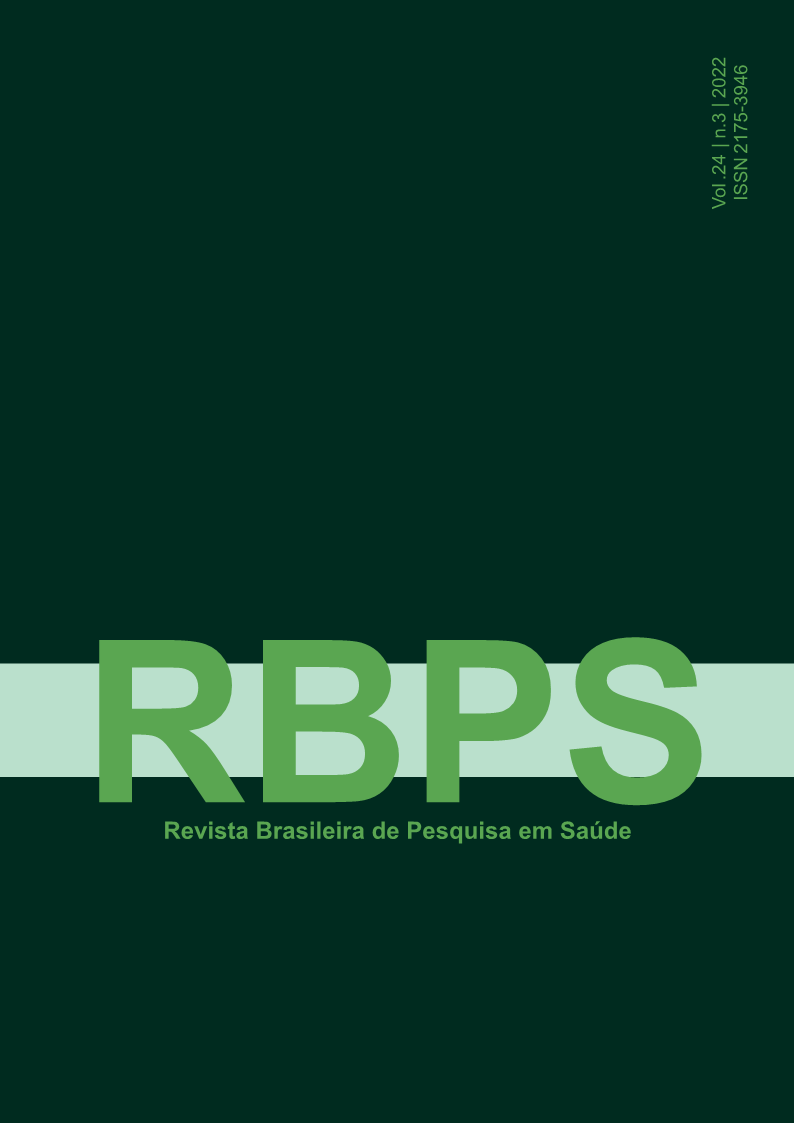Immune-mediated acute neuropathies: an immunological analysis of patients hospitalized for Guillain-Barré syndrome in the years 2020-2021 at a university hospital in Vitória, ES, Brazil
DOI:
https://doi.org/10.47456/rbps.v24i3.38987Keywords:
Guillain-Barré syndrome, Diagnostic techniques neurological, Patient acuityAbstract
Introduction:
When analyzing the increase in cases of Guillain-Barré Syndrome (GBS) admitted at a university hospital in Vitória, Es, Brazil, it was suggested to implement a simplified laboratory evaluation, widely available and low cost, which would allow the examiner to predict the risk of unfavorable evolution of the patient diagnosed with an Acute Immune-mediated Polyneuropathy. Objectives: Predict the greater severity of the patient with GBS at hospital admission, the unfavorable evolution of motor strength, in addition to the dependence on oxygen therapy, based on the laboratory analysis of the Total Neutrophils/Lymphocytes (NLR) ratio through the complete blood count (CBC). Methods: Patients with GBS and their admission CBC were evaluated. The data obtained was tabulated for statistical analysis with an appropriate small sample test. Results: NLR proved to be relevant and statistically significant as evidence of worse neurological status on patient admission and higher risk of death. Conclusion: There was statistical relevance of using NLR as an easily accessible and interpretable, besides widely available initial tool to contribute with the anamnesis and physical examination, providing more data for the examining doctor and allowing wide knowledge into the severity status of the patient with GBS.
Downloads
References
Kokcu A, Kurtoglu E, Celik H, Tosun M, Malatyalioglu E, Ozdemir AZ. May the platelet to lymphocyte ratio be a prognostic factor for epithelial ovarian cancer?. Asian Pac J Cancer Prev. 2014;15(22):9781-4.
Ethemoglu O, Calik M. Effect of serum inflammatory markers on the prognosis of adult and pediatric patients with Guillain–Barré syndrome. Neuropsychiatric Disease and Treatment. 2018;14:1255-1260.
Demirci S, Demirci S, Kutluhan S, Koyuncuoglu HR, Yurekli VA. The clinical significance of the neutrophil-tolymphocyte ratio in multiple sclerosis. The International journal of neuroscience. 2015;126(8)1-7.
Gokhan S, Ozhasenekler A, Mansur Durgun H, Akil E, Ustundag M, Orak M. Neutrophil lymphocyte ratios in stroke subtypes and transient ischemic attack. European review for medical and pharmacological sciences. 2013;17(5):653-657.
Tokgoz S, Kayrak M, Akpinar Z, Seyithanoglu A, Guney F, Yuruten B. Neutrophil lymphocyte ratio as a predictor of stroke. Journal of stroke and cerebrovascular diseases: the official journal of National Stroke Association. 2013;22(7):1169-1174.
Geyik S, Bozkurt H, Neyal M, Yigiter R. The Clinical Significance of the Neutrophil-to-Lymphocyte Ratio in Patients with Guillain-Barré Syndrome Independent of Infection. Medical Science and Discovery. 2016;3(8):305- 11.
Bruck I, Antoniuk SA, Cat R, Spessatto A, Halick SM, Bruyn LRD, et al. Imunoglobulina endovenosa em crianças com síndrome de Guillain-Barré. Arquivos de Neuro- Psiquiatria. 2000;58:1081-91.
Shahrizaila N, Lehmann HC, Kuwabara S. Guillain- Barre syndrome. Lancet. 2021 Mar 27;397(10280):1214- 1228.
De-Lucca MET; Maffini JF; Grassi MG; Stadler- Junior M; Bezerra VN; João PRD. Síndrome de Guillain- Barré na pediatria: revisão de literatura. Resid Pediatr. 2020;0(0):523.
Leonhard SE, Mandarakas MR, Gondim FAA, Bateman K, Ferreira MLB, Cornblath DR, et al. Evidence-Based Guidelines Diagnosis and management of Guillain–Barré Syndrome in ten steps. Rev Neurocienc. 2021;29:1-52.
Ozdemir HH. Analysis of the albumin level, neutrophil-lymphocyte ratio, and platelet-lymphocyte ratio in Guillain- Barré syndrome. Arq Neuropsiquiatr. 2016;74(9):718-722.
Yuki N, Chan AC, Wong AHY, Inoue T, Yokai M, Kurihara T, Devaux JJ, Wilder-Smith E. Acute painful autoimmune neuropathy: A variant of Guillain-Barré syndrome. Muscle Nerve. 2018 Feb;57(2):320-324. doi: 10.1002/mus.25738. Epub 2017 Jul 24. PMID: 28667708
Khanmohammadi S, Malekpour M, Jabbari P, Rezaei N. Genetic basis of Guillain-Barre syndrome. J Neuroimmunol. 2021 Sep 15;358:577651. doi: 10.1016/j. jneuroim.2021.577651. Epub 2021 Jul 1. PMID: 34246981
Querol L, Lleixà C. Novel Immunological and Therapeutic Insights in Guillain-Barré Syndrome and CIDP. Neurotherapeutics. 2021 Oct;18(4):2222-2235. doi: 10.1007/s13311-021-01117-3. Epub 2021 Sep 21. PMID: 34549385; PMCID: PMC8455117.
Leonhard SE, Cornblath DR, Endtz HP, Sejvar JJ, Jacobs BC. Guillain-Barré syndrome in times of pandemics. J Neurol Neurosurg Psychiatry. 2020 Oct;91(10):1027- 1029. doi: 10.1136/jnnp-2020-324230. Epub 2020 Jul 30. PMID: 32732383; PMCID: PMC7509514.
Downloads
Published
How to Cite
Issue
Section
License
Copyright (c) 2022 Brazilian Journal of Health Research

This work is licensed under a Creative Commons Attribution-NonCommercial-NoDerivatives 4.0 International License.
Authors and reviewers must disclose any financial, professional, or personal conflicts of interest that could influence the results or interpretations of the work. This information will be treated confidentially and disclosed only as necessary to ensure transparency and impartiality in the publication process.
Copyright
RBPS adheres to the CC-BY-NC 4.0 license, meaning authors retain copyright of their work submitted to the journal.
- Originality Declaration: Authors must declare that their submission is original, has not been previously published, and is not under review elsewhere.
- Publication Rights: Upon submission, authors grant RBPS the exclusive right of first publication, subject to peer review.
- Additional Agreements: Authors may enter into non-exclusive agreements for the distribution of the RBPS-published version (e.g., in institutional repositories or as book chapters), provided the original authorship and publication by RBPS are acknowledged.
Authors are encouraged to share their work online (e.g., institutional repositories or personal websites) after initial publication in RBPS, with appropriate citation of authorship and original publication.
Under the CC-BY-NC 4.0 license, readers have the rights to:
- Share: Copy and redistribute the material in any medium or format.
- Adapt: Remix, transform, and build upon the material.
These rights cannot be revoked, provided the following terms are met:
- Attribution: Proper credit must be given, a link to the license provided, and any changes clearly indicated.
- Non-Commercial: The material cannot be used for commercial purposes.
- No Additional Restrictions: No legal or technological measures may be applied to restrict others from doing anything the license permits.

























